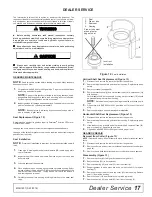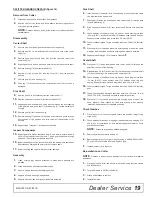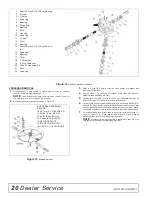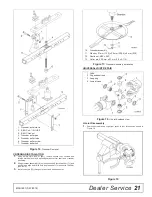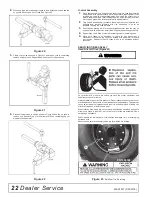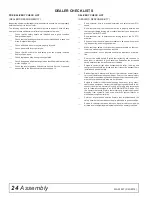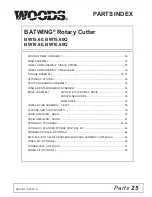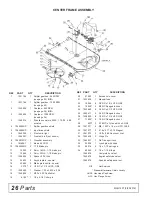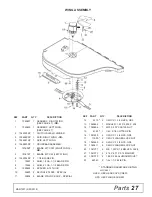
14
Owner Service
MAN1257 (3/23/2018)
LUBRICATION
Do not let excess grease collect on or around parts, particularly when operating
in sandy areas.
See Figure 4 for lubrication points and frequency or lubrication based on nor
-
mal operating conditions. Severe or unusual conditions may require more fre
-
quent lubrication.
Use a lithium grease of #2 consistency with a MOLY (molybdenum disulfide)
additive for all locations unless otherwise noted. Be sure to clean fittings thor
-
oughly before attaching grease gun. One good pump of most guns is sufficient
when the lubrication schedule is followed.
Gearbox Lubrication
For gearbox, use a high quality gear oil with a viscosity index of 80W or 90W
and an API service rating of GL–4 or –5 in gearboxes. Fill gearbox until oil is
above lower line on dipstick. Check gearbox oil level daily for evidence of leak
-
age, and contact your dealer if leakage occurs. Check vent plug periodically
and clean if it does not relieve pressure.
Driveline Lubrication
1.
Lubricate the driveline slip joint every eight operating hours. Failure to
maintain proper lubrication could result in damage to U-joints, gearbox,
and driveline.
2.
Lower cutter to ground, disconnect driveline from tractor PTO shaft, and
slide halves apart but do not disconnect from each other.
3.
Apply a bead of grease completely around male half where it meets
female half. Slide drive halves over each other several times to distribute
grease.
Seasonal Lubrication
In addition to the daily recommended lubrication, a more extensive application
is recommended seasonally.
1.
Fill CV double yokes with 20 pumps of grease with the joints in a straight
line.
2.
Articulate CV body to maximum angle several times to ensure full
coverage of joints.
3.
Place joints in the straight position and a add 10 additional pumps of
grease to both joints.
4.
Wipe telescoping drive clean of all old grease and contaminants.
5.
Add a thin layer of new grease over telescoping drive.
BLADES
Before working underneath, read manual instructions, securely
block up, and check stability. Secure blocking prevents equipment from
dropping due to hydraulic leak down, hydraulic system failure, or
mechanical component failure.
Blade Removal (Figure 5)
Figure 5
. Blade Assembly
1.
Disconnect driveline from tractor PTO.
2.
Raise cutter and block securely (see Figure 4).
3.
Align crossbar (8) with blade access hole in the cutter frame. Remove
cap screw (16), blade pin lock clip (15), keyhole plate (14), spacer (13),
and shims (11 & 12). Carefully drive blade pin (10) out of crossbar.
4.
Rotate crossbar and repeat for opposite blade.
NOTICE
■
If blade pin (10) is seized in crossbar and extreme force will be
needed to remove it, support crossbar from below to prevent gearbox
damage.
Blade Installation (Figure 5)
Your dealer can supply genuine replacement blades. Substitute
blades may not meet original equipment specifications and may be dan
-
gerous.
NOTICE
■
Crossbar rotation has clockwise rotation on left gearbox and coun
-
terclockwise rotation on the right and center gearboxes when looking
down on cutter. Be sure to install blade cutting edge to lead in correct
rotation.
NOTE:
Always replace or sharpen both blades at the same time.
1.
Inspect blade pin (10) for nicks or gouges, and if you find any replace the
blade pin.
2.
Insert blade pin through the blade. Blade should swivel on blade pin; if it
doesn’t, determine the cause and correct.
3.
Align crossbar (8) with blade access hole in cutter frame. Make sure
blade offset is down away from cutter.
4.
Insert blade pin (10) through blade. Push blade pin through crossbar.
5.
Install shims (11 & 12) and spacer (13) over blade pin.
NOTE:
Only use enough shims to allow keyhole plate (14) to slide into
blade pin groove.
6.
Install blade clip (15) over keyhole plate and into blade pin groove.
7.
Secure into position with cap screw (16). Torque cap screw to 115 Nm.
8.
Grease pin via zerk at end of pin.
9.
Repeat steps for opposite side.
NOTE:
Blade should be snug but should swivel on pin without having
to exert excessive force. Blade should not move more than a 6 mm up or
down at the tip. Keep any spacers not used in the installation as replace
-
ments or for future installation.
Blade Sharpening
NOTICE
■
When sharpening blades, grind the same amount on each blade to
maintain balance. Replace blades in pairs. Unbalanced blades will cause
excessive vibration, which can damage gearbox bearings. Vibration may
also cause structural cracks to cutter.
1.
Sharpen both blades at the same time to maintain balance. Follow
original sharpening pattern.
2.
Do not sharpen blade to a razor edge—leave at least a 1.6 mm blunt
edge.
3.
Do not sharpen back side of blade.
WARNING
8. CROSSBAR ASSEMBLY
9. BLADE
10. 38.1mm BLADE PIN
11. SHIM 18 GA
12. SHIM 20 GA
13. 5/16 SPACER
14. KEYHOLE PLATE
15. BLADE IN LOCK CLIP
16. 1/2 NC X 1-1/4 HHCS GR5
CAUTION
Summary of Contents for Batwing BW10.60E
Page 9: ...Declaration of Conformity9 MAN1257 3 23 2018...
Page 30: ...30 Parts MAN1257 3 23 2018 TONGUE ASSEMBLY...
Page 54: ...BATWING FAUCHEUSE ROTATIVE MAN1257 R v 23 03 2018 BW15 60E BW15 60QE BW10 60E BW10 60QE...
Page 62: ...D claration de conformit 9 MAN1257 23 03 2018...
Page 76: ...BATWING TRINCIATRICE ROTANTE MAN1257 Rev 23 03 2018 BW15 60E BW15 60QE BW10 60E BW10 60QE...
Page 84: ...Dichiarazione di conformit 9 MAN1257 23 03 2018...
Page 98: ...BATWING ROLLSCHNEIDER MAN1257 Rev 23 03 2018 BW15 60E BW15 60QE BW10 60E BW10 60QE...
Page 106: ...Konformit tserkl rung 9 MAN1257 23 03 2018...
Page 120: ...BATWING DESBROZADORA GIRATORIA MAN1257 Rev 23 3 2018 BW15 60E BW15 60QE BW10 60E BW10 60QE...
Page 128: ...Declaraci n de conformidad 9 MAN1246 14 12 2017...

















